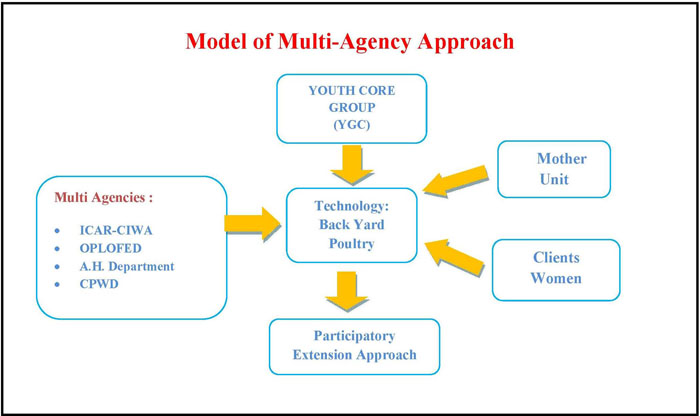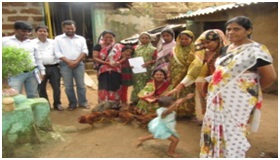Technologies for Women in Agriculture => Models & Methodologies
MULTI AGENCY PARTICIPATORY EXTENSION MODEL FOR LIVELIHOOD IMPROVEMENT OF FARM WOMEN THROUGH BACKYARD POULTRY
Back ground
The major problem of farm women in poultry rearing has been observed that they are very rarely included in any skill training for their capacity building. They are lacking scientific practices of poultry production. They are also ignorant about sources of chicks, feed, immunizations, other marketing agencies, etc. But they require more earning and employment round the year. This is possible when the farm women become trained and aware of locally existing institutions. So, the need of the hour is to enhance the skill of women through involvement of local multi-agencies to ensure more earning and techno-socio-economic empowerment.
Technology description
- The project designed in action research mode to evaluate the effects of the model on sustainability of backyard poultry farming by involving the resource poor farm women.
- The Youth Core Group (YCG including 1 male + 1 female) was selected with some criteria from four experimental villages to act as a bridge between the villagers and the agencies
- The identified multi-agencies were distributed their respective roles and responsibilities
- The Mother Unit concept was introduced in the villages to rear the day old chicks up to one month to reduce the mortality rate.
- Provision was made for monthly honorarium/service charge of YCGs
- The capacity was built for both the Youth Core Groups and the farm women through training, demonstration, exposure visit and literatures.
- Youth Core Groups gave tips to render advisory services, advocacy, and meetings and organize demonstrations.
- Feedback and transfer of solutions were taken up through telephone calls and visits
- Monitoring, concurrent evaluation, case studies, problem analysis, productivity analysis and group dynamics were taken up during the period of project implementation.

How it is women friendly?
- Provides family nutrition, the domain of women
- Women become decisive in management
- Needs less investment
- Women have more affinity towards homesteads where backyard poultry exists
- The model emphasized gender needs
- Developed women leadership in the locality
- Provide attractive colour egg and chicken to family
- Can be adopted by small, marginal and land less farm women
Performance:
- Created awareness in the locality for rearing backyard poultry
- SC,ST, OBC and resource poor women derived maximum benefits
- Increased knowledge and skill of farm women in the areas of care and maintenance of mother units, vaccination of the birds, feeding and drinking, and marketing.
- Provided additional income of farm women by selling egg and meet
- Improved family nutrition, employment and skill
- Developed small women entrepreneurship
Locale of dissemination/ application:
(i) Bhubaneswar (Padasahi)
(ii) Jatani (Haridamada, Guptapada and Angarpada)
Outcomes/impact/benefits:
- Developed multi agency extension model
- Gender sensitization among stakeholders
- Publications
- Success stories
Limitations if any
- Youth Core Group members may very easily quit their responsibilities
- May demand for higher honorarium or other benefits by threatening
- No job security for YCGs
Photos
 |
 |
Source (author/organization):
Sabita Mishra, Anil Kumar and Ananta Sarkar, ICAR-Central Institute for Women in Agriculture, Bhubaneswar, Odisha
Developed/tested/refined:
Developed and tested
Year and purpose:
- 2013-2016 for sustainability of enterprises with multi agencies involvement
Cost:
- Contingency: Rs 43.28 Lakhs
Patent/Commercialization:
- Nil
Weather further study/ modification are required or not:
- Yes, needs further replication in different locations for validation of the model.

